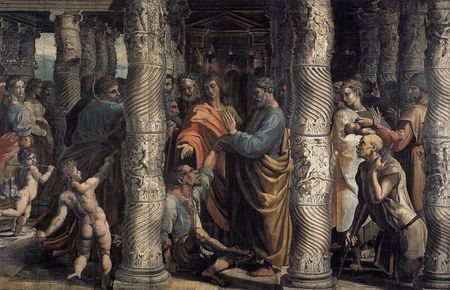You have no items in your cart. Want to get some nice things?
Go shopping
I’ve been going to galleries. I’ve been going to museums. Staring at grand Raphael painting’s in the V&A. Jesus, his disciples, the Last Supper, and Crucifixion. No one paints like this anymore. The techniques, the narratives, everything has changed. It’s moved with the generations, becoming more opaque. I worry then that this means I in turn am becoming archaic. I tell myself it’s just a change of scene, to change a style. I tell myself that when I have a voice unique to me, everything else will fall into place.
Pick a writer whose work you admire, and try to write like them. Eventually you’ll find that your own style comes through.
This was the best advice I was given as a Creative Writing undergraduate. As a Masters student, I am now expected to explain this style, and all choices made, in the form of reflective essays. I’m told it is to get me thinking about my writing, so I might understand it better. The truth is though; I don’t, and never have, understood it. I am influenced as much by Joy Division and Scott Walker, as I am by James Salter and Simone De Beauvoir. The stories I create, at least in theory, are striving towards a combination of all these elements. They need a rhythm, electronic, but ambient. They need a vision, neon, but glacial.
In the past I have jumped from a Kerouac like spontaneous prose, to an intense, on edge, narrative based on early Knut Hamsun writing. I found these hard to maintain though. They felt forced. Of course there was a common thread, in terms of content, but they lacked the starkness, and space I was looking for, in order to find something different. That works quickly and economically, in terms of mood, and atmosphere, like a classic album, say an Unknown Pleasures, or Tago Mago.
Confused I turned to those already where I am looking to be. They said,
This can’t be done. You’re wasting your time.
They said,
Writing is about narrative, plot, and structure. Forget the style, forget ambience.
They pointed me back in the direction of what’s come before, as I myself have often turned. Increasingly though, it is becoming less helpful, and the irony is, that many of the greats of the past rejected what came before them, and if not, they bent it, and shaped it into something their own. This happens all the time, with everything from football to fashion. To move forward we take what we need and leave the rest behind.
In many respects though there is only so far you can go. Music for example will always have a limited amount of notes. So similarities between the chord structures and melodies of songs are commonplace. These notes however can be manipulated by a host of different instruments, and keys, in a range of diverse styles. So when songs do share a similar sonic palette they can still achieve strikingly different outcomes.
Take for instance Radiohead’s gloomy, Motion Picture Soundtrack from Kid A. In essence it is the depressed young sibling of The Beatles White Album closer Good Night. The soaring, angelic backing vocals, the lush strings, the way the songs float towards their conclusion, and yet Thom Yorke’s falsetto lamenting cheap sex and sleeping pills produces something altogether darker and more melancholic than Ringo’s endearingly nasal, Disney like, lullaby. Meaning one becomes an almost Orwellian Hymn, and the other becomes a nostalgic vision of a future, where the listener is simultaneously both child and parent.
Now in respect to literature there are theories, which suggest that in everything from The Hunger Games to Heart Of Darkness there will be characteristic plot devices and structures that date back centuries. There are also hundreds of books written about how books should be written. For my Masters I am marked on specific criteria based upon what all writing has done, and is supposed to do. If then these ingredients are part of some universal literary DNA, and all writers have to follow them, then perhaps the only thing that truly separates one work from another is style.
Climbing the walls with this thought, shouting at trains, I found myself forced to repeat it all again, to a friend entrenched in her own ever spiralling project. She said,
Style. Never worry about it. I worry about characterisation, and plot.
Everyone says that. What if we’re all just writing the same stories though? What separates say Hemingway from Faulkner? Style. People remember their styles.
What. No. You’re moving too far from what you’re supposed to be doing. Concentrate on the story.
Unsatisfied by the off hand dismissal I decided to relay this to a friend who isn’t a writer, but is always happy to indulge in conversations of cultural relevance.
This is interesting. What you’re saying. You’re moving toward a kind of Pop-lit.
Ambient maybe. What I am wondering though, is if literature needs to become something more abstract? Less fixed, like modern art.
It’s not the job of a writer to be abstract. Actually it’s the opposite. What you need to be is subversive, Ballard via Henry Miller, with a concrete emotional narrative.
Maybe.
Look, really, all you need to do is write what you want to read.
Write what I want to read?
You can’t sit around second-guessing what people want. When you start writing something, ask yourself, would I want to read this? If you don’t, your reader won’t.
What do I want to read? The stories I am interested in usually focus on individuals, lost, isolated in their own drifting lives. This can be Fight Club or The Bell Jar, but it could also be Crash or Ask The Dust.
I said,
I don’t think this is going to help me. I’m stuck in the past, but I want the future.
What do you mean?
I mean one minute I think novels should be lean, like Point Omega. Then I think they need to be big expansive affairs that immerse the reader, like War And Peace.
So you want distance, and immediacy. You want crisp, economic, immersion.
Yes.
He proceeded to tell me that this is all sounded like an unhealthy act of self-sabotage. That I’m creating problems, and pressure, that isn’t really there. Perhaps it’s why I am still sat in the V&A staring at Raphael’s The Healing Of The Lame Man, contemplating the elements of style. What I should be doing is building bridges. The Futurist’s, the Modernists, they did this. By combining everything that inspired them, with what they wanted, and what they thought, literature could be, they produced unique works still discussed and dissected today. In being seduced completely by style, we can ultimately sacrifice substance. The best writers achieve both. Woolf, Faulkner, Hemingway, they all did this, because they knew that in the end, movements pass, trends change, and all that remains are the stories.

About Reece Choules
Reece Choules is a regular contributor to both Litro and The Culture Trip. He lives and works in South London.



